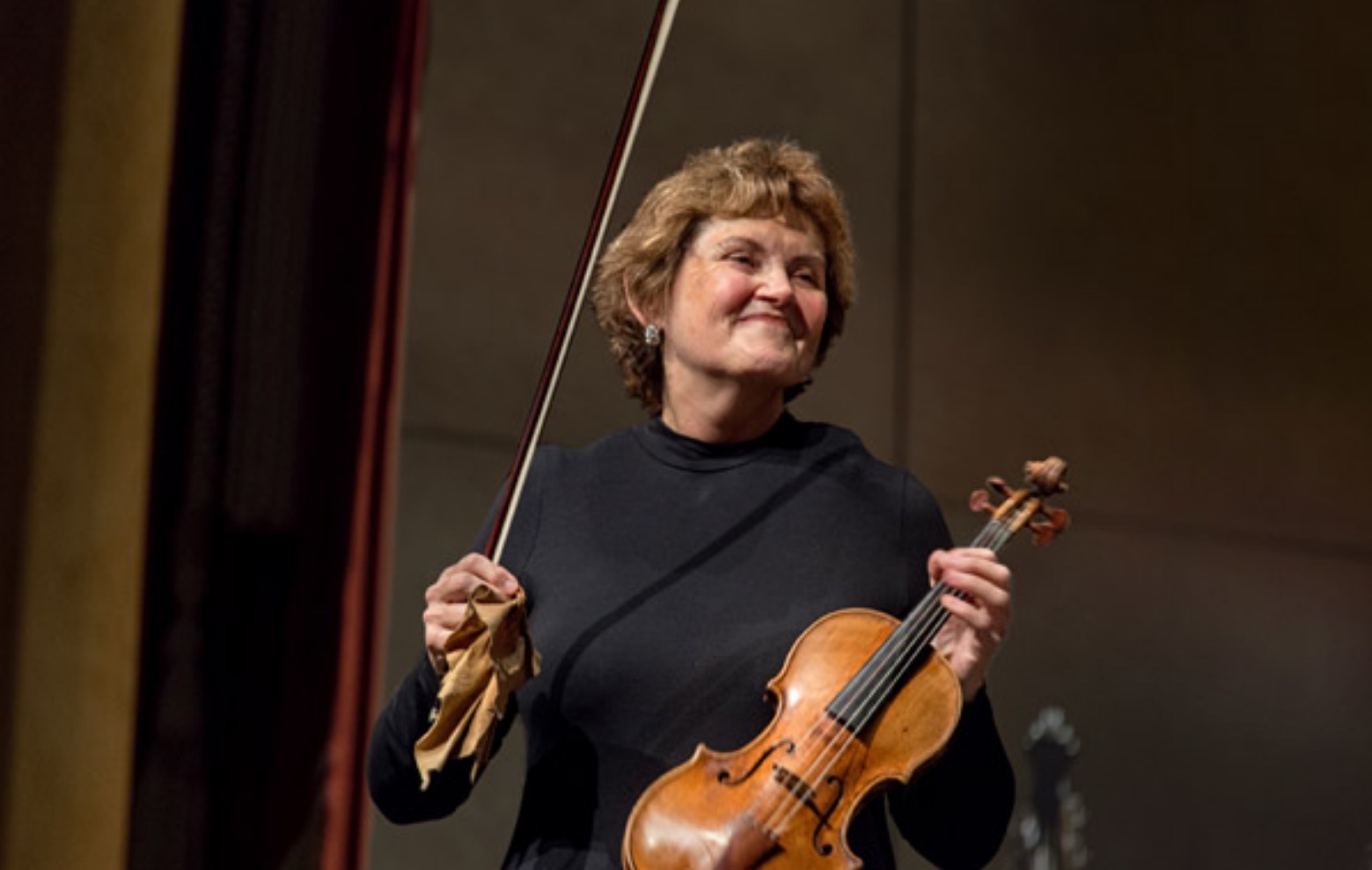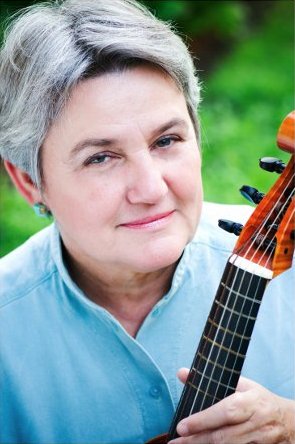 The SFEMS series resumes the weekend of January 11–13 with a program of middle baroque music performed by the Ars Lyrica Houston Chamber Players. Elizabeth Blumenstock, violin; Mary Springfels, viola da gamba; and Matthew Dirst, harpsichord will explore the Stylus phantasticus, that most avant-garde mode of music-making among German composers of the 17th and early 18th centuries. Their concert will feature extravagant works for violin, viola da gamba, and harpsichord. All three instruments are featured individually and in combination on this program, in sonatas by Dietrich Buxtehude and Heinrich Ignaz Franz Biber, two of best-known exponents of the “fantastical style,” alongside free works by August Kerzinger, Philipp Heinrich Erlebach, Johann Jakob Walther, and Johann Sebastian Bach.
The SFEMS series resumes the weekend of January 11–13 with a program of middle baroque music performed by the Ars Lyrica Houston Chamber Players. Elizabeth Blumenstock, violin; Mary Springfels, viola da gamba; and Matthew Dirst, harpsichord will explore the Stylus phantasticus, that most avant-garde mode of music-making among German composers of the 17th and early 18th centuries. Their concert will feature extravagant works for violin, viola da gamba, and harpsichord. All three instruments are featured individually and in combination on this program, in sonatas by Dietrich Buxtehude and Heinrich Ignaz Franz Biber, two of best-known exponents of the “fantastical style,” alongside free works by August Kerzinger, Philipp Heinrich Erlebach, Johann Jakob Walther, and Johann Sebastian Bach.
Founded in 1998 by harpsichordist and conductor Dirst, Ars Lyrica Houston presents a diverse array of music from the 17th and 18th centuries on period instruments. They are the leading early music group in Texas, and their pioneering efforts have won international acclaim, including a Grammy Award nomination for their world premiere recording of Johann Adolf Hasse’s Marc’Antonio e Cleopatra in 2011. In 2014, they were presented on the Main Stage at the Berkeley Festival. Blumenstock and Springfels, together with Dirst, formed the subset of Ars Lyrica Chamber Players several years ago, performing programs in Houston and Santa Fe, New Mexico. Their concerts in the Bay Area next month mark their West Coast premiere as a trio, though each individually has a lengthy history in the region.
In the following notes, the three members of this distinguished chamber group introduce the music on their SFEMS program.
* * *
 The stylus phantasticus so widely used in German Baroque music might be thought of as “serious fun.” In his enormously influential Musurigia Universalis (1650), the polymath Athanasius Kircher gives the term a definition that invites many interpretations: “The fantastic style is especially suited to instruments. It is the most free and unrestrained method of composing, it is bound to nothing, either to words nor to a melodic subject, it was instituted to display genius and to teach the hidden designs of harmony and the ingenious composition of harmonic phrases and fugues.”
The stylus phantasticus so widely used in German Baroque music might be thought of as “serious fun.” In his enormously influential Musurigia Universalis (1650), the polymath Athanasius Kircher gives the term a definition that invites many interpretations: “The fantastic style is especially suited to instruments. It is the most free and unrestrained method of composing, it is bound to nothing, either to words nor to a melodic subject, it was instituted to display genius and to teach the hidden designs of harmony and the ingenious composition of harmonic phrases and fugues.”
Through the music of Heinrich Biber, who was trained by Kircher, we can easily grasp the gist of the above description. More broadly, however, virtually all Baroque music displays harmonic cohesion at some level, either in its overall plan or in the harmonic implications of its musical inventions. In addition to the spontaneity and virtuosity described by Kircher, the fantastic style also often included the most complex polyphonic interplay of voices, which he called “fugue,” whose realization may fall to a single player (at the organ or harpsichord, for example) or to a diverse company of musicians.
Biber’s sonatas run quite a gamut of instrumentation and comprise five published sets, along with several single sonatas, two of which are exclusively for violin and continuo. The preeminent violin virtuoso of the seventeenth century, Biber championed the use special techniques including scordatura, which refers to the alternate tuning of the instrument’s four strings to facilitate certain chords and alter tonal qualities. The violin sonata on this program, which employs scordatura in a unique way, is not from his famous “Rosary Sonatas” of 1676 but rather from an unnamed set of eight sonatas published in 1681. Its noble canzona-like opening gives way to a lengthy passacaglia, both of which are realized with “normal” violin tuning. After two bars of rest, the violinist either takes up second instrument (tuned in scordatura) or hastily retunes her E string down to D for the rest of the work. Its various sections also include a gavotte and an extravagant closing lament.
 As often happened in the Baroque era, the Germans took their cue from the Italians, whose stile moderno sonatas made the most of the new rhetorically-inflected expression that gave birth to opera around 1600. Antonio Bertali, one of many Italian musicians who brought this style across the Alps, served the imperial court in Vienna for over forty years. A master of all genres, Bertali is known to us primarily as a composer of chamber works, which include a famous Ciaccona and several solo sonatas in the flamboyant style of his contemporaries. Bertali’s larger ensemble sonatas, including several a 6, likely inspired interest in the stylus phantasticus among German and Austrian composers. Even in this A-minor Sonata a 2 from the Partiturbuch Ludwig (1662), Bertali includes surprisingly adventurous harmonic progressions. Its concise kaleidoscope of figuration, emotion, and counterpoint closes with a truly bizarre little Presto.
As often happened in the Baroque era, the Germans took their cue from the Italians, whose stile moderno sonatas made the most of the new rhetorically-inflected expression that gave birth to opera around 1600. Antonio Bertali, one of many Italian musicians who brought this style across the Alps, served the imperial court in Vienna for over forty years. A master of all genres, Bertali is known to us primarily as a composer of chamber works, which include a famous Ciaccona and several solo sonatas in the flamboyant style of his contemporaries. Bertali’s larger ensemble sonatas, including several a 6, likely inspired interest in the stylus phantasticus among German and Austrian composers. Even in this A-minor Sonata a 2 from the Partiturbuch Ludwig (1662), Bertali includes surprisingly adventurous harmonic progressions. Its concise kaleidoscope of figuration, emotion, and counterpoint closes with a truly bizarre little Presto.
Michelangelo Rossi’s Toccata Settima is a somewhat extreme example of the analogous keyboard genre: in this case, a “touch piece” with stark, sudden contrasts of styles and obsessive chromaticism. “Susanne ung Jour,” in the middle of our initial set, represents the slightly older practice of viola bastarda division-playing, which Francesco Rognoni brought to its apogee during the same era.
Among German composers especially, the violin and viola da gamba became natural partners in the trio sonata genre, perhaps simply because the very different sonorities of these instruments produce a diverse palette of potential colors. Some of the finest works for this particular combination can be found in Dietrich Buxtehude’s two volumes of trio sonatas for violin and viola da gamba, published in 1694 and 1697; this program features two sonatas from the first collection. The ease with which Buxtehude intertwines violin and viol parts in these supple trios is remarkable. Among his contemporaries, only Henry Purcell’s effortless virtuosity comes close.
With Buxtehude the “fantastic style” takes on new heft and dimension. His trio sonatas, though still in the sectional mode, offer more substantial sections and greater depth of expression. The A-minor Sonata’s various sections include an early fugal episode worthy of Corelli plus a couple of intensely chromatic Adagios. The G-major Sonata, while equally ambitious, wears it learning more lightly. Its obvious Gemütlichkeit summons instead a spirited (and perhaps well-lubricated) musical salon.
The Bohemian August Kerzinger, about whom little is known, clearly understood the prevailing national idioms, including the Italianate sonata and its kid sister, the “sonatina.” Kerzinger’s Sonatina for viola da gamba and basso continuo, like Buxtehude’s sonatas but on a smaller scale, includes several short but artfully connected sections.
The two books of Bach’s Well-Tempered Clavier offer a comprehensive catalogue of both free and fugal styles of composition, as realized in 48 preludes and fugues in all the major and minor keys by the greatest genius of the German Baroque. From Book I (1722), a prelude and fugue in B-flat major begins with a fantastic-style toccata, while a prelude and fugue in A minor from Book II (1742) offers a binary-form prelude with two invertible contrapuntal voices and a dramatic fugue that mixes freely a stile antico-style subject with stylus phantasticus figuration.
The life of Philipp Heinrich Erlebach is something of a cypher. All we know of him is that he was a court musician in Thuringia, and that he was a very productive composer, a maker of chamber music, cantatas, and large concerted pieces for Lutheran worship. Unfortunately, most of his output was destroyed in a fire in 1735. Among the few musical survivors is Erlebach’s collection of six sonatas for violin, viol and continuo, printed in 1694, from which comes the closing work on this program. This lovely A-major sonata, which mixes freely the Italian and French modes, comprises a serene Adagio, a Gallic Allemande, a Courante bristling with hemiolas, a graceful Sarabande, a fine Ciaconne, and meltingly beautiful Final.
* * *
Performances take place 8:00 p.m., Friday, January 11, at First Presbyterian Church, 1140 Cowper Street at Lincoln, in Palo Alto; 7:30 p.m. Saturday, January 12, at St. Mark’s Episcopal Church, 2300 Bancroft Way, in Berkeley; and 4:00 p.m. Sunday, January 13, at St. Mark’s Lutheran Church, 1111 O’Farrell at Gough, in San Francisco. Tickets are available online, through the SFEMS box office at 510-528-1725, or at the door 45 minutes before each performance.












